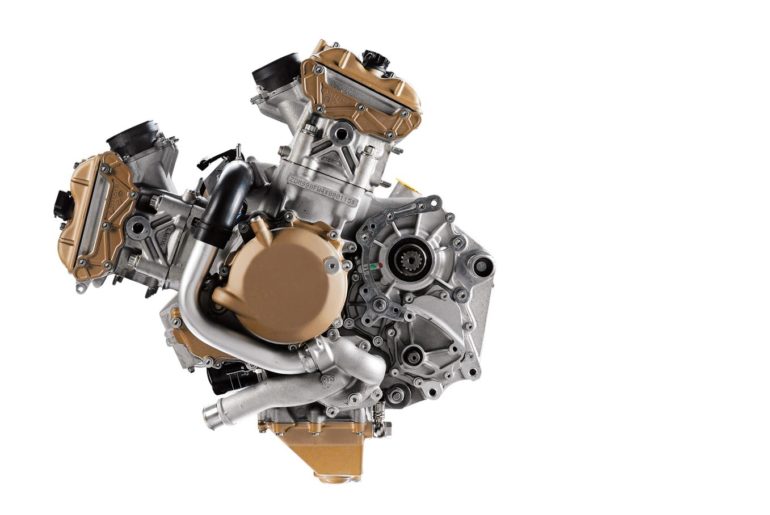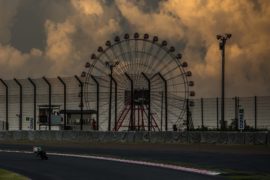Over the long weekend, we got our first real glimpse of Ducati’s new V4 superbike – just a few days ahead of the company’s debut of its new V4 engine, which has been named the Desmosedici Stradale.
This is not the name of Ducati’s new superbike, as some outlets have been reporting, instead we learned the name of the actual motorcycle, at the same time the spy photo dropped. It will be called the Ducati Panigale V4.
Though the letters are blurry, and the photo is disappointing of low-quality, just knowing this new superbike’s name tells us a great deal about Ducati’s new superbike program, and where the brand is headed for the future.
When spy photos of the Panigale V4 first debuted, it was obvious that the machine captured by photographers took a number of visual cues from its predecessor.
This wasn’t a test mule in sheep’s clothing however, with there being enough key differences in the bodywork shape for it to be obvious that Ducati was keeping the general look and feel of the Panigale for its V4 successor.
Now with Ducati recycling the Panigale name, it is clear that the Bologna factory isn’t quite ready to do away with its namesake. This is an interesting development for the Italian brand.
Revolution, Not Evolution
When the rumors first started that Ducati was moving away from a v-twin superbike platform, a move that would see a four-cylinder machine as the future water-carrier for this robust heritage of Italian performance, my initial expectation was that it would also come with a ground-up new design.
With the V4 engine being such a large departure from Ducati’s sacred v-twin engine history, the transition that the Desmosedici Stradale engine marks should be met with an equally historic model, from my humble opinion.
With the Panigale V4 model though, Ducati isn’t adding a new chapter to its iconic story. Instead, it is creating a whole new tome – one that will be filled with coming chapters about other V4 models and motorsport dominance.
As such, the expectations of myself and other Ducatisti was that the new V4 superbike would be a clear sea change for Ducati.
We thought that the upcoming Ducati Panigale V4 would be a noticeable inflection point on Ducati’s model timeline and history – a point where the Italian firm made a clear change in its thinking and trajectory.
Ducati’s superbike history is marked with such models, with each generation of the bike’s design casting its own unique shadow on the brand.
From the 916 to the 1299, Ducati has riffed unique songs with each superbike model, and we thought the V4 would be no different – offering another unique beat and melody to the Ducati superbike compilation.
Would the V4 have winglets, like we saw last season the MotoGP machine? Would this be another masterpiece is aesthetics? Would we talk about the V4 model the same way we talk about Tamburini’s 916, or would it be a polarizing design, like Terblanche’s 999? The possibilities were limitless.
So, imagine our surprise when the first glimpses of the new V4 superbike showed a familiar visage. The face of the Ducati Panigale V4 is so similar to the old one, the most entrenched Ducatisti have still not accepted it as true.
You would expect Ducati to want to define the Panigale V4 against its predecessor, something that is done with first impressions, like the design of the bike’s bodywork, its construction quality, its color schemes.
But instead, we were offered something very similar to before, and this no accidental choice.
Evolution, Not Revolution
The name Ducati Panigale V4 tells us a quite a bit about Ducati’s reasoning for keeping its V4 superbike visually so similar to its v-twin predecessor.
By drawing a visual link between the outgoing Ducati 1299 Panigale and the incoming Ducati Panigale V4, the Italian brand is helping build a bridge for its most loyal fans to cross over.
In some ways too, this design continuity also helps to suggest the notion that the Panigale lineup as a whole is Ducati’s pivot away from its most sacred cows.
When the Ducati 1199 Panigale debuted, it took the Italian brand away from one of its most iconic pieces, the steel trellis frame.
Instead of the lattice arrangement the Ducatisti had come to expect from Borgo Panigale, Ducati decided to pioneer with a new “frameless” chassis design – one that used the engine as an integral part of the chassis, and also one that allowed for a massive weight savings from the overall machine.
Now showing its second iteration of its “frameless” chassis, complete with longer spars that reach further back along the motorcycle (due to the V4 Desmosedici Stradale engine being raked rearward even further than its predecessor), Ducati is looking to improve upon this novel idea that it first set upon in 2011.
Desmodromic, But Problematic
Ducati’s chassis philosophy shows great promise on paper, but that has been tougher to translate into reality, with the handling of the Ducati 1199/1299 Panigale being one of the chief complaints made about the model, by journalists and racers alike.
The concept has merit though, and when you consider the early-days reality of this chassis design, Ducati’s monocoque frame is deserving of further development, which brings us to the Ducati Panigale V4.
Now in the evolution stage of its chassis revolution, the Italian brand is left free to address its next rate-limiter, the v-twin engine platform.
With superbike horsepower figures reaching beyond 200hp now for street going models, it was clear that Ducati had reached the limits of the v-twin motor configuration with the Superquadro engine.
The only way forward for Ducati was with more engine cylinders, or a breakthrough with Newtonian physics. In that, Ducati’s MotoGP program offered an easy solution, with Ducati Corse’s 1,000cc 90° V4 engine with desmodromic valves being the most potent in the paddock.
With a long-bang firing order, Ducati has assured us that the Desmosedici Stradale engine is unlike any other motor on the market, and while certain aspects of the V4 engine can be found in other designs, we too are confident that Ducati has created something unique.
Staying the Corse
Like Ducati’s chassis concept though, we too foresee the Ducati Panigale V4 as just the first step of many for the Italian brand and this new engine type. And like the true engineer that he is, Ducati CEO Claudio Domenicali has been smart about how he evolves his motorcycle company.
Smart changes are made in increments. Developing, testing, and refining new technologies into perfection. Progress is more often made with careful and measured changes, instead bold and broad sweeping upheavals.
Ducati’s MotoGP program is proof of this, with Gigi Dall’Igna making incremental changes to Ducati’s factory, team, motorbike, and riders over his tenure.
He didn’t throw the baby out with the bath water when he arrive at Ducati Corse, but instead looked for improvements across the board, made them, measured their results, and then made his next step.
As such, the current GP17 isn’t all that dissimilar from the GP12, but every Desmosedici GP race bike since 2014 onward has been a noted improvement on the one that preceded it, and careful evolution is the reasons for this.
Being able to commit to a design philosophy and iterate upon it – staying the course despite the results – has been a huge part of Ducati’s success, both in MotoGP and WorldSBK paddocks.
With Andrea Dovizioso leading the MotoGP Championship going into the Desmosedici Stradale’s debut, Ducati has its proof in the pudding, and now the next step is to make a similar result in the World Superbike Championship.
It’s no mistake too that Ducati’s most successful riders have been the ones who have stayed the course with the brand’s evolution.
A Panigale by Any Other Name
Taking what it knows from the Ducati 1299 Panigale (which should be noted is an evolution from the 1199 machine), the Ducati Panigale V4 continues this trend of measured growth.
The expectation may have been to debut in November another all-new superbike, wowing the assembled crowd with the best ideas that Borgo Panigale has to offer. Doing so would have been a marketer’s dream, since “new” sells itself; “new” grabs headlines; and that “new” excites the base.
But as we saw with the Ducati 1199 Panigale, new doesn’t always work, once the flash has subsided and the novelty has worn off.
So, that leaves us with Ducati’s new superbike being an evolution of the old, at least that is what the Italian brand is telegraphing with its naming choice. The Ducati Panigale V4 is to be pushed as the next generation of Panigale superbike, not the next generation of Ducati superbike – though it is also very much the latter.
This is not the choice that a marketing-focused CEO would make, but it is the kind of approach that we would expect from an engineering-focused CEO, like Claudio Domenicali.
Typing this, it turns me to something that Domenicali said to Asphalt & Rubber while talking about the new V4 superbike a couple months back:
“We do not consider it that companies should stay still for long periods of time,” he said. “But, sometimes companies use some kind of technological solution as a flag, only because they are not able to think of something different.”
By keeping the Panigale name for his new V4 model, Domenicali is proving his point that he is not in the business of making something “new” for the sake of having something new in his company’s motorcycle lineup.
The Ducati Panigale V4 is the next step in the Italian company’s ability to think of something different though. We know this, because the name on the bike tell us so.
Photo: Ducati




